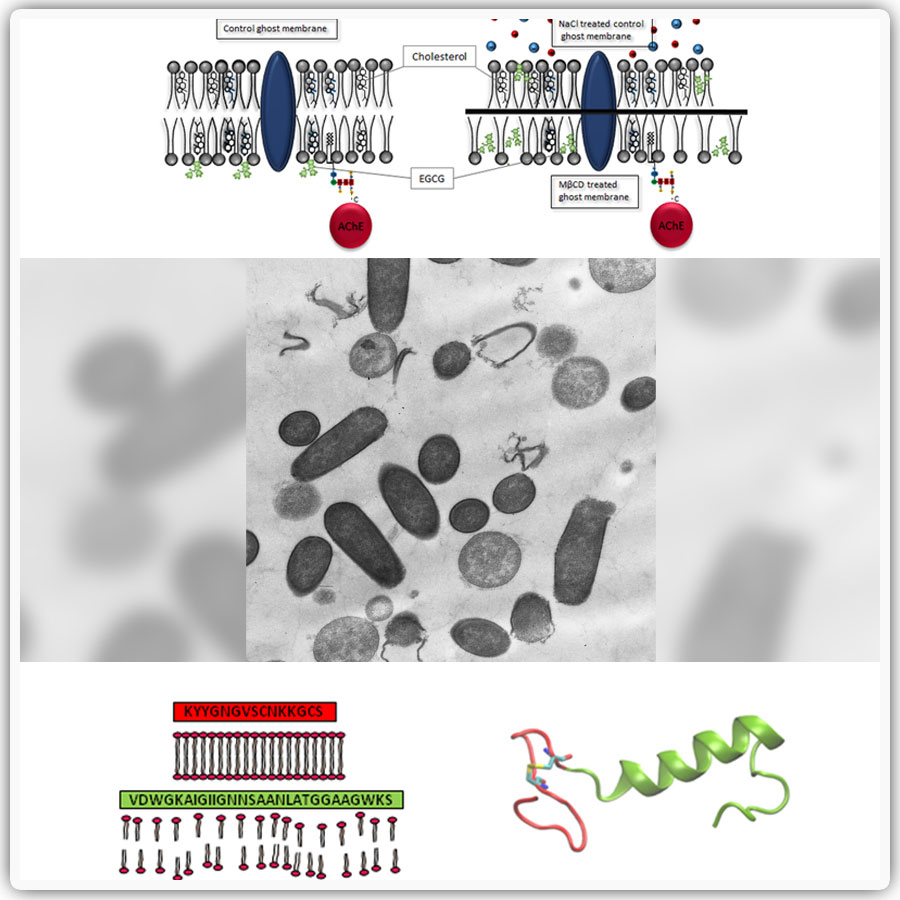The group studies the interaction of antimicrobial peptides and polyphenols with biological membranes.
The analysis of the mechanism of action of cationic peptides allow us to deepen the understanding of the interaction with membranes. Then, we can analyze the possible application of these peptides in the control of Listeria monocytogenes in food and as adjuvant therapy in the treatment of enterococcal infections.
The bacteriocin enterocin CRL35 produced by the bacterium Enterococcus mundtii CRL35, studied by researchers from CERELA and INSIBIO, is used as a model.
Regarding the polyphenols, the possible regulation that these compounds would exert on the activity of membrane proteins is investigated.
The ABCG1 transporter and the acetylcholinesterase enzyme (AChE), which are related to cholesterol transport and neurodegenerative diseases, are used as model proteins.
Among the techniques used are: fluorescence (ISS PC1 spectrofluorometer, SLM 4048c spectrofluorometer, Perkin Elmer LS-55 Fluorescence Spectrometer), Langmuir monolayers (Nima 102 M), infrared spectroscopy (FTIR Nicolet 5700), purification of proteins and lipids (Amersham Pharmacia FPLCs, AKTA GE Healthcare, Gilson HPLCs), molecular biology techniques, basic and clinical microbiology and culture of eukaryotic cells.
We work in collaboration with Dr. Augusto Bellomio (INSIBIO), Dr. Lucila Saavedra (CERELA), Dr. Cecilia Rodríguez (CERELA), Dr. Nancy Freitag (University of Illinois College of Medicine – Chicago, USA), Dr. Eduardo Cilli (Paulista State University – Araraquara, Brazil), Dr. María José Rodríguez Vaquero ( Faculty of Bqca., Qca. And Fcia., UNT – CONICET), Dr. Martin Fanzone (INTA, Mendoza), Dr. Laura Bonofiglio (Faculty of Pharmacy and Biochemistry – UBA) and Dr. Guillermo Altenberg (Texas, Tech University Health Sciences Center – Lubbock, USA).
1. Interaction of enterocin CRL35 with model membranes.
Listeria monocytogenes is a bacterium that survives and multiplies at low temperatures, which makes Listeria particularly problematic for food preservation.
Active agents at the level of biological membranes, such as bacteriocins, represent interesting alternatives for the control of L. monocytogenes, which is able to grow in different conditions by manipulating the composition of the membrane fatty acids.
The group studies the interaction of amphipathic peptides with membrane model systems that allows us to find critical molecular determinants of the mechanism of action of enterocin CRL5 in Listeria.
This project is directed by Dr. Fernando Dupuy.
2. Application of enterocin CRL35 in the control of pathogenic enterococci infections.
Enterococcus faecium and Enterococcus faecalis are opportunistic pathogens implicated in a large number of nosocomial infections.
The group studies the interaction of enterocin with clinical isolates belonging to multiresistant enterococcus species.
Our objective is to achieve the use of the bacteriocin enterocin CRL35 as adjuvant therapy, in nosocomial infections.
This project is directed by Dr. Emilse Masias (INSIBIO), in collaboration with Dr. Cecilia Rodríguez and Dr. Lucila Saavedra from CERELA and the Bacteriology Laboratory of the Ernesto C. Padilla Hospital from San Miguel de Tucumán.
3. Design of a culture medium for E. mundtii CRL35
Enterocin CRL35 is secreted in low concentrations by E. mundtii CRL35. This lactic acid bacterium grows in complex culture media; therefore, it is necessary to design a cheaper culture medium that allows production at large scale.
The milk whey is a by-product of the dairy industry that has no major application at present. Therefore, the use of whey as the base for bacterial culture media will give added value to this by-product and will have a positive impact in the region.
The group is developing a whey-based medium as a possible growth substrate for E. mundtii CRL35.
The subject is directed by Dr. Juan Farizano.
4. Inhibition of the enzyme acetylcholinesterase (AChE) by polyphenols.
Acetylcholinesterase is the enzyme responsible for hydrolyzing acetylcholine and is associated with autoimmune, neurodegenerative and infectious pathologies.
Our group studies the inhibition of AChE by phenolic compounds present in white and red grape pomace.
The pomace is a by-product of the wine industry that is obtained from the alcoholic fermentation of the must, and is characterized by its high content of polyphenols.
The theme is directed by Dr. Carlos Minahk.
SALAZAR, PB; DUPUY, FG; DE ATHAYDE MONCORVO COLLADO, A; MINAHK, CJ
Membrane order and ionic strength modulation of the inhibition of the membrane-bound acetylcholinesterase by epigallocatechin-3-gallate
BIOCHIMICA ET BIOPHYSICA ACTA-BIOMEMBRANES; Año: 2018
MASIAS E; DUPUY F; DA SILVA SANCHES PR; FARIZANO J; CILLI E; BELLOMIO A; SAAVEDRA L; MINAHK C
Impairment of the class IIa bacteriocin receptor function and membrane structural changes are associated to enterocin CRL35 high resistance in Listeria monocytogenes
BIOCHIMICA ET BIOPHYSICA ACTA-GENERAL SUBJECTS; Lugar: Amsterdam; Año: 2017 vol. 1861 p. 1770 – 1776
SALAZAR, PB; DE ATHAYDE MONCORVO, A; CANAL, V; MINAHK, C
Differential inhibition of human erythrocyte acetylcholinesterase by polyphenols epigallocatechin-3-gallate and resveratrol. Relevance of the membrane bound form
BIOFACTORS; Lugar: Amsterdam; Año: 2017 vol. 43 p. 73 – 81
DE ATHAYDE MONCORVO, A; DUPUY, F; MORERO, R; MINAHK, C
Cholesterol induces surface localization of polyphenols in model membranes thus enhancing vesicle stability against lysozyme, but reduces protection of distant double bonds from reactive-oxygen species
BIOCHIMICA ET BIOPHYSICA ACTA-BIOMEMBRANES; Lugar: Amsterdam; Año: 2016 vol. 1858 p. 1479 – 1487
SAAVEDRA, M. L.; MINAHK, C; DE RUIZ HOLGADO, A.; SESMA, F.
Enhancement of the enterocin CRL35 activity by a synthetic peptide derived from the NH2-terminal sequence.
ANTIMICROBIAL AGENTS AND CHEMOTHERAPY; Año: 2004 vol. 48 p. 2778 – 2781
PFIP-ESPRO. “Innovations and promotion of Tucumán wine”. Function performed: director.
PICT 0924. “Molecular interactions between lactic bacteria and polyphenols and their relationship with the intestine-brain axis. Implications in neurodegenerative diseases ”. Function performed: responsible group researcher.
PIUNT 2018 D641/2. “Development of heterologous vaccines against enteropathogenic strains prevalent in the Argentine Northwest based on attenuated Salmonella mutants ”. Function performed: researcher.
PIP 0530. “Development of a bioprotective culture intended to mitigate enterohemorrhagic E. coli in meat and meat products ”. Director: Silvina Fadda. Function performed: responsible group researcher.
Independent Researcher, CONICET
email: cminahk@fbqf.unt.edu.ar
Assistant Researcher, CONICET
email: fdupuy@fbqf.unt.edu.ar
CONICET
email: paubsalazar@gmail.com
CONICET
email: cordobajosefina@hotmail.com
CONICET
email: franfeito650@hotmail.com
CONICET
email: jfarizano@fbqf.unt.edu.ar
CONICET
email: emilmas@hotmail.com
Teaching Assistant UNT
email: carolinamedinaamado@gmail.com
Student
email: emilsearaoz48@gmail.com
Student
email: maurogarnica92@gmail.com)




